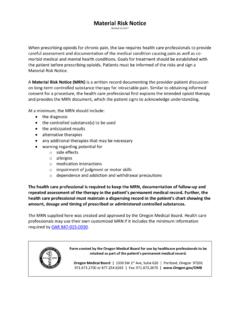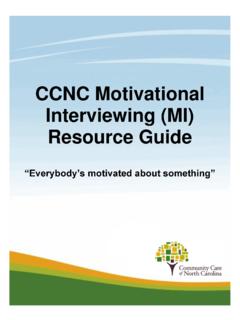Transcription of THE OARS MODEL1 ESSENTIAL COMMUNICATION SKILLS
1 Motivational Interviewing THE OARS MODEL1 . ESSENTIAL COMMUNICATION SKILLS . is a SKILLS -based model of interactive techniques adapted from a client- centered approach, using motivational interviewing principles. These skill-based techniques include verbal and non-verbal responses and behaviors. Both verbal and non-verbal techniques need to be adapted to be culturally sensitive and appropriate. The OARS Model includes four basic SKILLS : O = Open Questions A = Affirmations R = Reflective Listening S = Summarizing The purpose of referring to the OARS model is to: 1) Provide us with a common language when teach COMMUNICATION SKILLS . 2) Provide us with a checklist of SKILLS as we do our on-going SKILLS self- assessment. 3) Provide us with a format to help us be intentional when working with our patients/clients. Using SKILLS intentionally helps us become more efficient and more effective in the work that we do. O = OPEN QUESTIONS. As a professional, one of the most important SKILLS (techniques) you will use with clients is open- ended questions.
2 Using this skill effectively can save a lot of time in each client session. When you use open questions effectively, your client is usually doing most of the talking. The purpose of using open questions is to: Establish a safe environment, and build trusting and respectful relationship. Explore, clarify and gain an understanding of your client's world. Learn about the client's past experience, feelings, thoughts, beliefs, and behaviors. Gather information client does most of the talking. Help the client make an informed decision. EXAMPLES Ask: 1. What do you do to protect yourself from pregnancy or STDs including HIV? 2. What has worked in the past? 3. How would you feel if you found out you were pregnant (or HIV positive)? 4. How can I help you today? 1. Miller, , & Rollnick, S.; Motivational Interviewing: Preparing People for Change, 2nd Edition. New York: Guilford Press, 2002. Center for Health Training 1. 2010. Motivational Interviewing Sometimes closed questions are appropriate: 1.
3 Have you had a pregnancy test? 2. Have you had sex without using birth control in the last three months? 3. Was it your choice to have sex? Avoid Why questions; use How or What instead: Why questions can put a person on the defensive. Listen to how these questions sound. Why Better What or How . 1. Why didn't you use condoms with a new partner? What did you do to protect yourself? 2. Why did you wait so long to come to the clinic? What made it hard to come to the clinic? 3. Why don't you use condoms every time? How often do you use condoms? Using What or How in your questions can often bring you the information you need without asking the client to justify a decision or behavior. A = AFFIRMATIONS. The skill (technique) that is often forgotten is the simple affirmation statement to a client about what he or she has already done, or a personal strength, or ability. An affirmation takes very little time, but it does require that you listen very carefully to what a client is telling you and find opportunities to acknowledge the positive aspects of your client's life.
4 The purpose of using affirmation statements is to: Build rapport; demonstrate empathy; affirm exploration into the client's world. Affirm the client's past decisions, abilities, and healthy behaviors. Build a client's self efficacy an ability to believe they can be responsible for their own decisions and their lives. EXAMPLES. 1. Use appropriate silence, attentive body posture, and appropriate eye contact. 2. Maintain relaxed facial expression and voice tone. 3. Use statements of appreciation, understanding, and positive feedback. 4. I am so glad you came into the clinic today it isn't always easy the first time. 5. You are really taking care of yourself, when you protect yourself against an unintended pregnancy and STDs. R = REFLECTIVE LISTENING. The most challenging skill (technique) is to listen reflectively to your patient. This skill also requires that you listen very carefully, observe your client's body language and behavior and reflect using your own words and perceptions.
5 Using this skill effectively promotes the most movement in a client's awareness. This part of your intervention can help a client make more intentional decisions and consider behavior changes. Center for Health Training 2. 2010. Motivational Interviewing The purpose of using reflective listening is to: Demonstrate to the client that you are listening and trying to understand his situation. Offer the client an opportunity to hear her own words, feelings and behaviors reflected back to her. Reflect the client's thoughts, feelings and behaviors. Reflect the client's general experiences and the in the moment experience of the clinic visit. The following are types of reflective listening: 1. Simple reflection (repeat the client's words). 2. Reflecting feelings (reflect what the client might be feeling). A format for reflecting feelings: You're feeling _____ because _____.. 3. Reflecting behavior (state observation about the client's behavior). A format for reflecting behavior: I noticed you just _____.
6 What are you thinking? -or- What are you feeling right now? . 4. Amplified reflection (rephrase the client's words - exaggerated). 5. Double-sided reflection (client's words + note ambivalence and point out discrepancy). 6. Shifting focus (going back to something else or changing the direction). 7. Rolling with resistance (accept the client's perception). 8. Reframing (invite client to examine his/her perception in a new way). S = SUMMARIZING. Summarizing, which may also include paraphrasing, is the skill that will help the provider and the client move through a session to transitions & closure. Summarizing can be demonstrated in three (3) variations: 1. A collective summary So let's go over what we have talked about so far.. 2. A linking summary A minute ago you said you wanted to talk to Maybe now we can talk about how you might try .. 3. A transitional summary So you will make an appointment today before you leave and maybe we will see you again soon.. Summarizing SKILLS keep you and your client on the same page throughout your session.
7 In addition, summarizing the session will help you close your session with the client's plan of action. Center for Health Training 3. 2010. Motivational Interviewing +. R = Roll with Resistance When you sense that signs of an argument are present, stop the conversation and indicate that the intent is not to take sides but that you are seeking understanding of his/her point of view. Argument, confrontation, lectures, and fear tactics lead to client resistance. This can be perceived by the client as judging and typically breeds defensiveness. Resistance is behavior that occurs when two people have their own point of view. Resistance occurs when the provider is moving the client ahead too quickly, or the provider has failed to understand something that is very important to the client. When resistance appears it is time to do something different. If your client is resistant, change your strategy. Strive for collaboration by: Asking open-ended questions to clarify. Can you tell me more about what happens when you try to use condoms?
8 Summarizing what you have heard from the client Are you hearing correctly? So it sounds like you feel comfortable using condoms when you are with a partner you have known for awhile and are able to talk about sex. But it is more difficult when you have a new partner like at this time in your life. Reflective listening to reframe a client's statement and offer a positive perspective on what the client has already done. I know you said you are really frustrated and don't know what to do. But you are talking with me about it and it seems like you want to do something different. Reflective listening to turn the question back to the client. The client has the solution. As we talk about contraceptive options and your relationship with your partner it seems like there might be more going on what am I missing? D = Develop Discrepancy The focus of MI is on developing discrepancy between the client's behavior and broader goals and values. Most often people are motivated to change when they hear it from themselves rather than from someone else.
9 Guide the discussion to allow the client to share personal values/beliefs regarding what is important for them and their future goals. Listen closely for statements about life, health, financial status, living situation and any other personal considerations. Examples of using open-ended questions: How have you protected yourself from HIV and STDs in the past? What might happen if you got HIV or herpes or Chlamydia? Example of double-sided reflective listening noting a discrepancy (using the client's words): You said that you haven't been using condoms and yet you also said that you REALLY don't want to get an STD. How do those two things fit for you? Center for Health Training 4. 2010.













